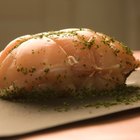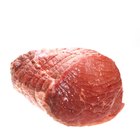
A chuck roast is taken from the cow's neck and shoulder area and has a high proportion of fat to lean as well as gristle. The Texas Beef Council recommends cooking a chuck roast in liquid, which tenderizes the meat by dissolving the fat and softening the gristle.
Braising
Braising a chuck roast is done using a liquid, such as water, broth or wine, and low steady heat. The roast is first seared in hot oil in a deep pot or Dutch oven, which helps to develop its flavors. When all sides brown, remove the roast and add flavoring vegetables such as onions, garlic and celery. Saute these for one or two minutes and add other vegetables such as potatoes, carrots and parsnips. Return the chuck roast to the pot and add enough water, broth, wine or a combination to a depth of about halfway up the sides of the beef. Season with salt and pepper, cover the pot and bake it in an oven set at 175 degrees Fahrenheit for 4 to 6 hours or until the meat can be easily pulled apart with a fork.
Stewing
Stewing a chuck roast involves basically the same steps as braising, except that the meat and vegetables are completely submerged in the cooking liquid and cooked on the stove top instead of in the oven. Dust the roast with all-purpose flour and sear on all sides in hot oil. Saute the flavoring ingredients before adding other vegetables of your choice, place the meat on top, and add liquid to completely cover the top of the roast. Season with salt and pepper, if desired, and bring the liquid to a boil on high heat. Reduce to medium or medium-low, cover the pot and cook for about 2 hours or until the meat and vegetables are fork-tender.
Slow Cooker Method
Unlike braising and stewing, cooking the chuck roast in a slow cooker surrounds the meat with steam from a small amount of water, broth or other cooking liquid added along with flavorings and vegetables. For more depth of flavor, sear the roast separately before placing in the slow cooker, making sure all sides are brown and slightly crispy. This helps to develop the classic roasted flavor and creates a rich brown stock that can later be thickened for gravy.
Seasoning Choices
There are no hard and fast rules as to what seasonings to use when cooking a chuck roast. You can go the traditional route and stick to the basics such as onion and garlic, or you can incorporate sautéed peppers, whole bay leaves or spices such as paprika or allspice. The same goes for the stewing or braising liquid, which can be plain water, broth, tomato juice or tomato sauce, red or white wine, or even apple cider. Liquid seasonings such as Worcestershire sauce, Tabasco sauce or balsamic vinegar can also be used to add interest. How you decide on what seasonings to use depends entirely on the basic recipe and your imagination.
Related Articles

How to Use an Electric Roaster to Slow ...
How to Slow Cook a Pot Roast With Beef ...

How to Braise Pork
How to Cook Pre-Seasoned Porketta

How to Cook Beef Top Round Pot Roast

How to Cook Beef Topside in a Slow ...

How to Cook Beef Shoulder Muscle

How to Make a Roast in an Electric Fry ...

How to Make Beef Shank Tender

How to Braise an Eye of Round

How to Cook Pulled Beef Without a Slow ...

How to Cook a Boneless Top Sirloin ...
How to Cook Roast Beef in a Cast-Iron ...

How Long to Cook Steak at 150 Degrees ...
How to Cook a Choice Chuck Roast

How to Boil Frozen Conch

How to Store Cooked Ground Beef

How to Use a Roaster Oven to Cook a ...

Does Cooking at a Low Temperature for a ...

How to Make a Tender and Juicy Pot Roast
References
Writer Bio
Rachel Lovejoy has been writing professionally since 1990 and currently writes a weekly column entitled "From the Urban Wilderness" for the Journal Tribune in Biddeford, Maine, as well as short novellas for Amazon Kindle. Lovejoy graduated from the University of Southern Maine in 1996 with a Bachelor of Arts in English.
Photo Credits
Jupiterimages/Stockbyte/Getty Images